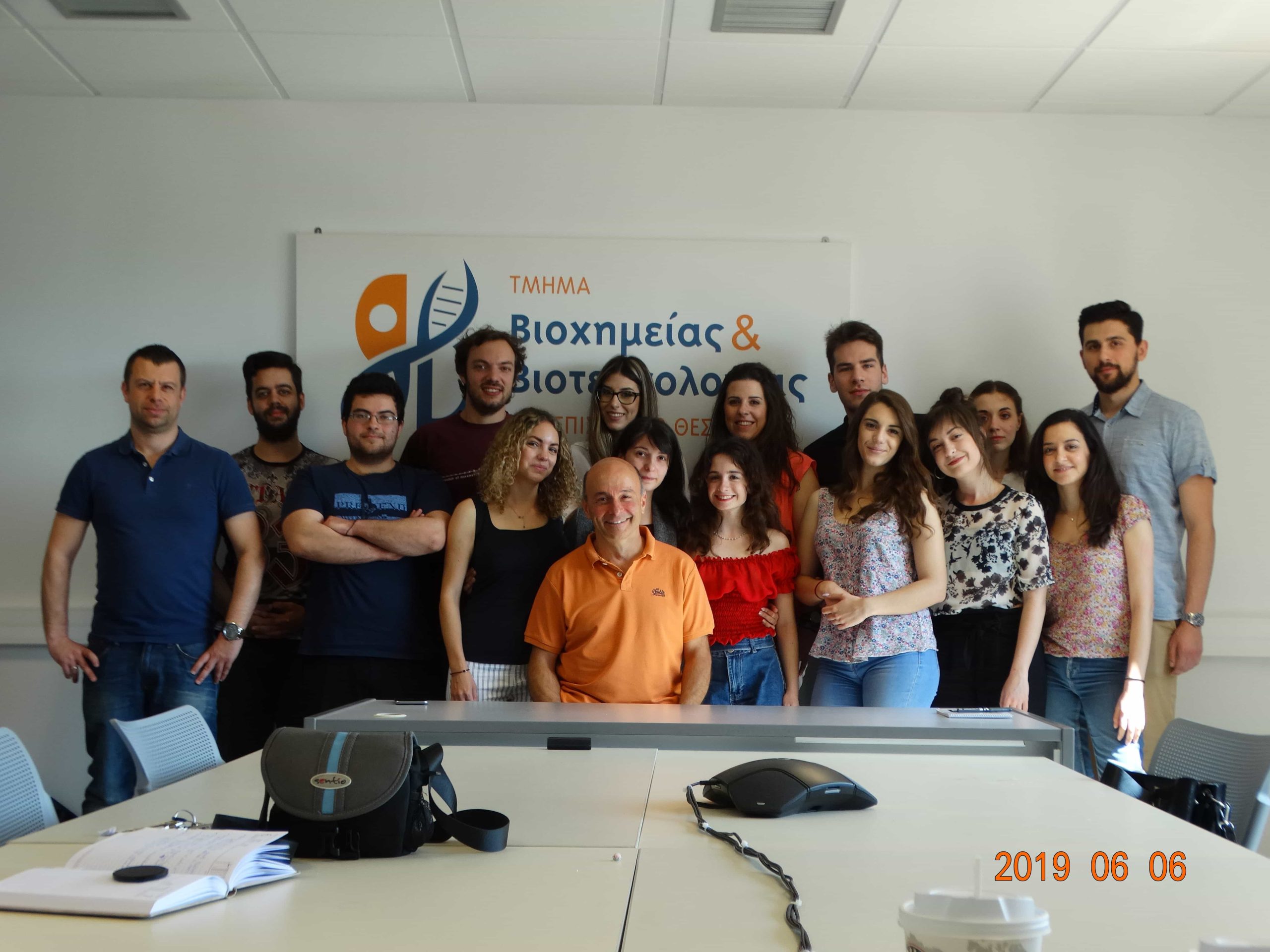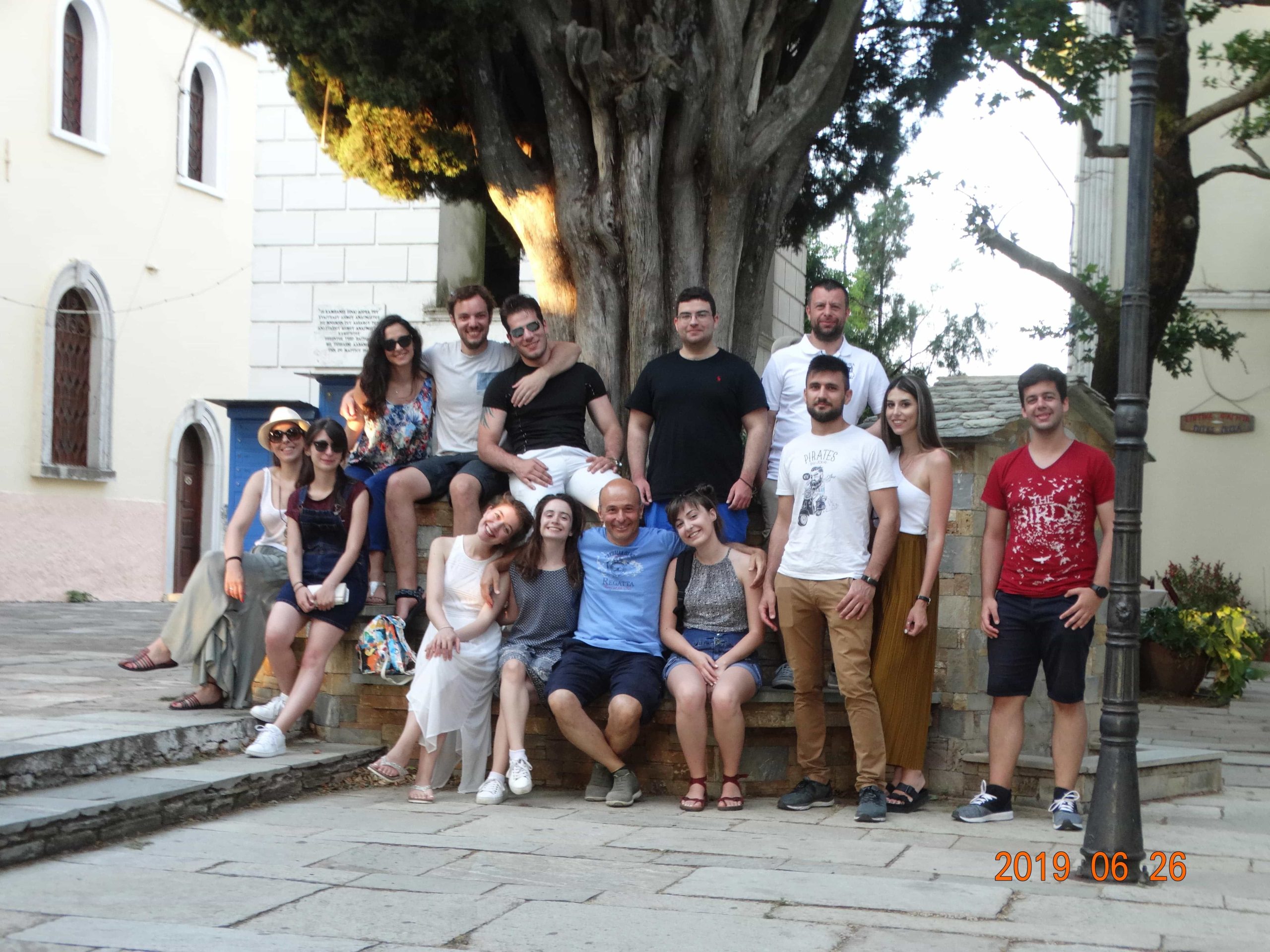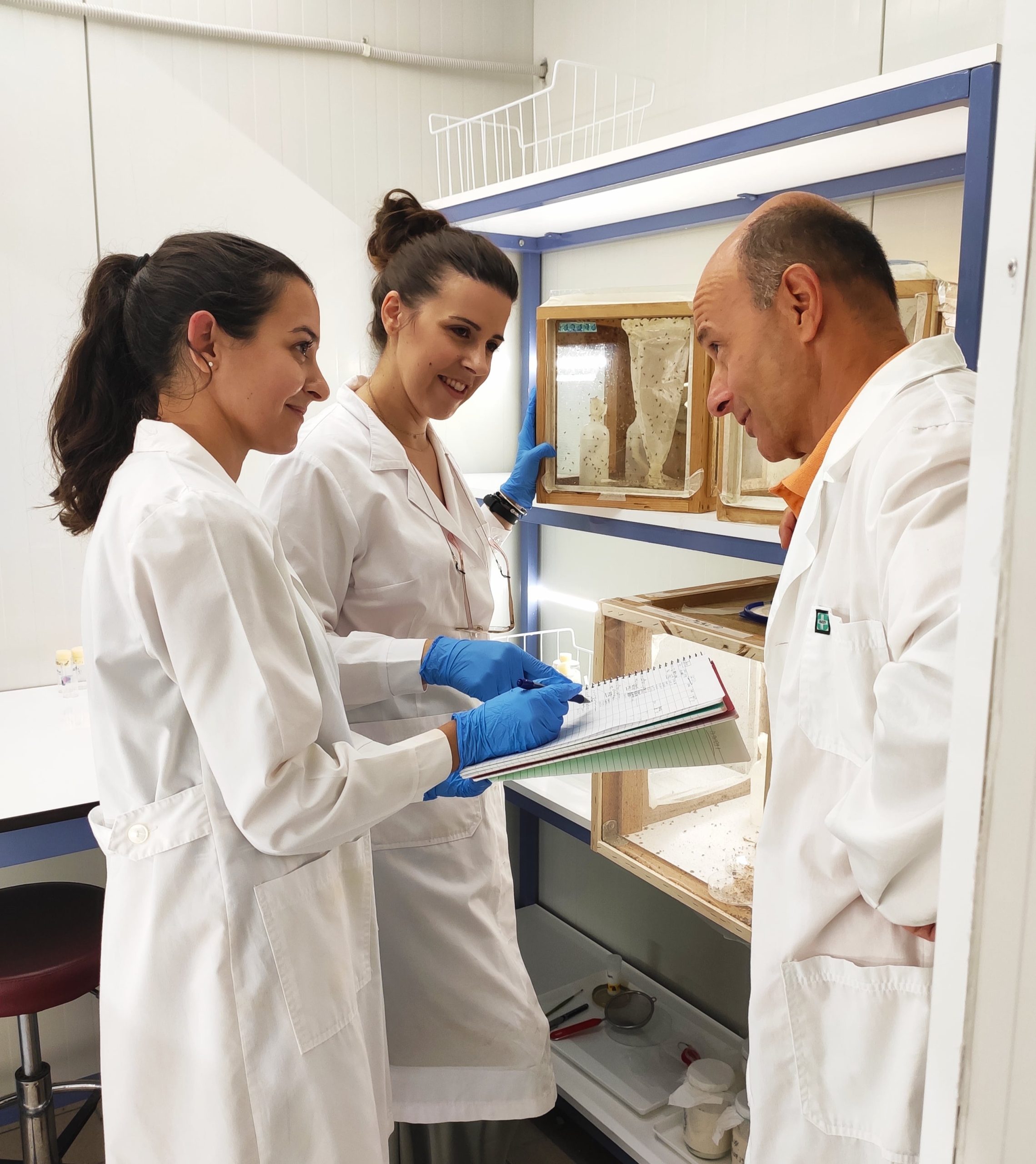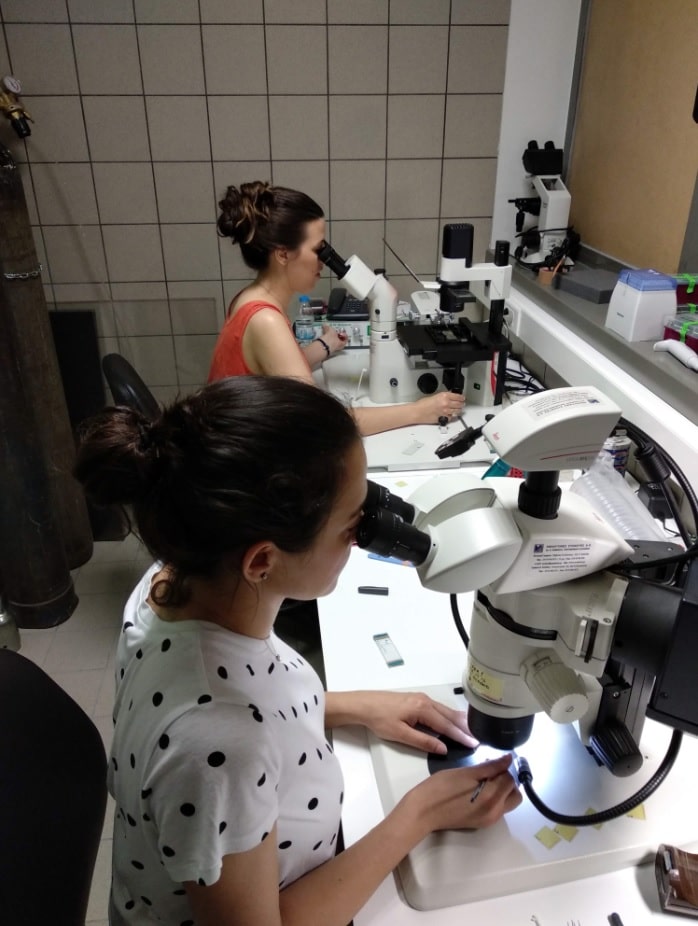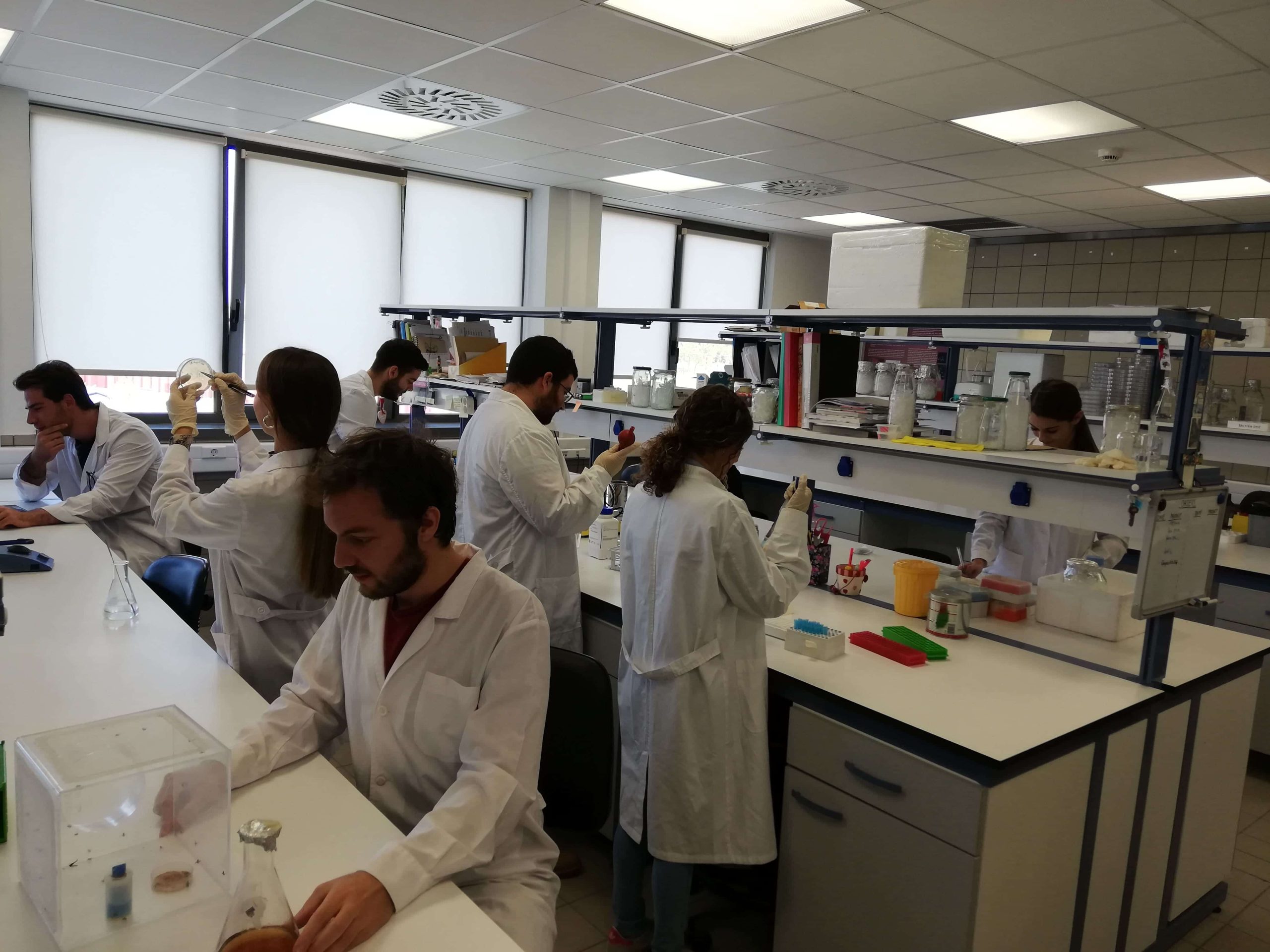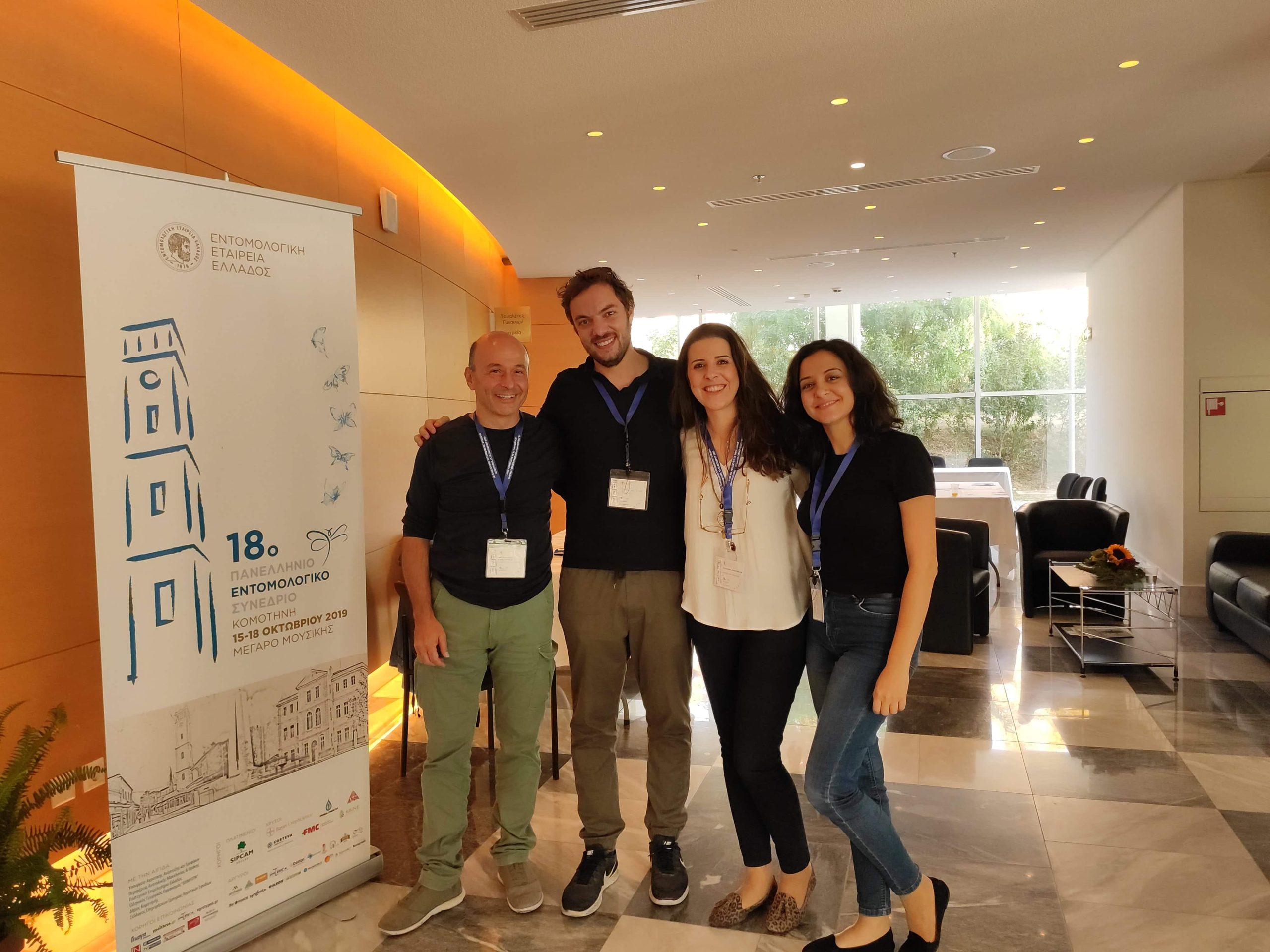Molecular Biology and Genomics
Brief Description
The advent of molecular biology in the last quarter of the 20th century has led to the development of large-scale techniques and the analysis of whole organism genomes, a field that is presently known as genomics. Our laboratory applies genomics approaches, in subjects related to the agricultural biotechnology and human diseases. The laboratory was officially founded by the FEK 511/3-4-2015.
Research interests
- Control of insect pests of agricultural & medical importance
- The major research direction of the laboratory of Molecular Biology & Genomics (MBG) is related to the molecular, genetic and genomic analysis of insect pests of both agricultural and medical importance. Our goal is to control the pests by applying environmentally friendly and chemical pesticide-free solutions. In particular, we study aspects of the olive fruit fly biology, the major pest of the olive cultivations, and its related species, the Mediterranean fly (Medfly) that affects more than 200 different species of fruit and vegetable cultivations worldwide. Moreover, recently we have started investigating the Asian tiger mosquito that invaded Greece over the last decade.
- Basic research and development of innovative tools
- Whole genome sequencing of the olive fly, focusing on the Y chromosome. This chromosome is difficult to assemble due to the presence of few genes and the large amount of sequence repeats that it contains.
- Study of the genomic content and structure of the Y chromosome of the olive fly. Our goal is to comprehend the evolution of this chromosome and elucidate the masculinization mechanism of the fly.
- Analysis of the olfactory and reproductive system of the olive fly, focusing in genes involved in the sexual behavior of the pre-mating communication and the fertility of the fly. Such genes could be exploited as targets of alternative pest management approaches.
- Basic research and development of innovative tools
- Development of innovative species-specific genetic control approaches against the olive fly, based on:
- The usage of a conditional lethal transgene, that causes the selective lethality of the female flies (female-specific Release of Insects carrying Dominant Lethal, fsRIDL), that lay their eggs inside the fruit, causing damage to the cultivations
- The sex-ratio distortion in favor of the male flies through the selective shredding of the X chromosome during spermatogenesis (Χ-shredding system), that will result in the collapse of the wild populations.
- Development of next generation species-specific insecticides
- Identification of novel species-specific molecular targets for the control of the Asian tiger mosquito and gene silencing through RNAi interference. Development of RNAi triggering platforms, through microorganisms, for field approaches of next-generation insecticides.
- Development of innovative trapping systems
- Development of lure-and-kill platforms, based on the production of novel synthetic molecules optimized to achieve the maximal activation of the olfactory receptors of the Οlive fly and the Medfly.
- Investigating the molecular function of non-coding RNAs in cancer
- The second research direction of the Molecular Biology and Genomics laboratory (MBG) focuses on the molecular function of non-coding RNAs in carcinogenesis with the use of genomic, molecular, bioinformatic and genetic approaches. The aim of our biomedical studies emphasizes on functional non-coding RNAs that are involved in cancer pathology, followed by the functional dissection of their role in the regulation of gene expression. More specifically, we are focusing on nuclear long non-coding RNAs, investigate their cancer-specific regulation from transcription factors, elucidate their molecular function through interactions with regulatory proteins and alteration of the 3D-chromatin architecture of cancer cells and finally evaluate their diagnostic and prognostic potential through clinomic analyses. Recently we have expanded our interest also to small non-coding RNAs in cancer.
- Detection and regulatory dissection of functional non-coding RNAs in cancer
- RNA-seq in cancer biopsies and cell lines
- ChIP seq for transcription factors and chromatin modifications in cancer biopsies and cell lines
- Functional characterization of long non-coding RNAs
- RNAi-mediated knock-down of target genes (shRNA, siRNA, ASOs etc)
- Transgenic overexpression
- CRISPR knock-out /cis-overexpression (CRISP-nCas/SNP, CRISPR-dCas activation/inhibition)
- smFISH
- RNA-protein and RNA-chromatin interactions
- RNA pull-down-MS, RNA immunoprecipitation and sequencing
- Chromatin Isolation by RNA purification-sequencing (ChIRP-seq)
- 3D-chromatin interactions
- Chromosome Conformation Capture
- 4C-seq
Personnel
- Teaching & Research Staff
- Mathiopoulos Kostas: Professor Molecular Biology
- Giakountis Antonis: Assistant Professor Molecular Biology – Genomics
- PhD Students
- Koskinioti Panagiota
- Belavillas-Trovas Alexandros:
- Begolli Rodiola-Eleni
- Leukothea Katsimani
- Spanomitrou Antonia
Funded Research Projects
- 2006-2008: Bilateral Greece-Cyprus R&T Collaborative Programmes of the General Secretariat of Research and Technology of the Ministry of Development, Greece, on “Assessment of resistance of natural olive fly populations to the naturalyte insecticide spinosad as well as investigation of the underlying molecular mechanism of such resistance”.
- 2005-2007: Research Potential Support Programme of the General Secretariat of Research and Technology of the Ministry of Development, Greece, on “Assessment of insecticide resistance in four insects of great economic importance (olive fly, green peach aphid, medfly and apple maggot fly), investigation of underlying resistance mechanisms and study of their bio-ecology.
- 2005-2006: University Research Teams Support Programme “Pythagoras ΙΙ” of the Greek Ministry of National Education and Religious Affairs on: «Molecular analysis of olive fly chromosomes, with emphasis on the Y chromosome, as well as use of molecular markers for the assessment of the fly’s invasion in California».
- 2004-2006: Bilateral Greece-Cyprus R&T Collaborative Programmes of the General Secretariat of Research and Technology of the Ministry of Development, Greece, on “Assessment of organophosphate and pyrethroid resistance of the olive fly”.
- 2009-2013: Coordinated Research Project of International Atomic Energy Agency entitled: “Assessment of Genetic Diversity of the Olive Fly Israeli SIT Laboratory Strain”.
- 2010-2012: Specialty Crops Block Grant Program from California Department of Food and Agriculture on: «Spinosad Resistance in California Olive Fruit Fly (Bactrocera oleae) Populations».
- 2010-2012: “Targeted Research Actions” Programmes of the University of Thessaly Research Committee, entitled: “HPV incidence in the upper respiratory system of the healthy human population of Thessaly”.
- 2010-2013: Research Potential Support Programme Heraclitus II of the Greek Ministry of Education on: “Transcriptomics and proteomics analysis of the most important olive pest, the olive fly Bactrocera oleae, focusing on sex-separation and insecticide resistance systems”.
- 2012-2014: Interdisciplinary and Interuniversity Research Support Program of the Greek Ministry of Education “Thales” entitled: “Symbiotic bacteria and ‘omics’ technologies towards the development of novel and environment-friendly control methods on insect pests: the case of the Mediterranean fruit fly”. Participation as Principal Investigator of Collaborating Team.
- 2012-2015: “Novel approaches to Olive fly control: focus on olfactory and reproductive systems”, implemented under the “ARISTEIA” Action of the “OPERATIONAL PROGRAMME EDUCATION AND LIFELONG LEARNING” and co-funded by the European Social Fund (ESF) and National Resources
- 2013-2014: “Sexing strains based on embryonic lethality for SIT in olive fly”, financed by the Programme for the promotion of the exchange and scientific cooperation between Greece and Germany (IKYDA 2013).
- 2013-2019: Coordinated Research Project of International Atomic Energy Agency entitled: “Comparing Rearing Efficiency and Competitiveness of Sterile Male Strains Produced by Genetic, Transgenic or Symbiont-Based Technologies”
- 2017-2019: Reinforcement of Postdoctoral Researchers by the State Scholarships Foundation (ΙΚΥ), entitled: “Α synthetic CRISPR/Cas9-based system to induce sex ratio distortion for the genetic control of the olive fruit fly, Βactrocera oleae”
- 2018-2021: Strengthening Human Resources Research Potential via Doctorate Research” implemented by the State Scholarships Foundation (ΙΚΥ), entitled: “Administration of species-specific dsRNA molecules as a novel approach for the management of major insect pests”
- 2018-2020: “Olive routes”, Greek National research network on the olive tree.
- 2018-2020: BioRoboost: Fostering Synthetic Biology standardisation through international collaboration. Η2020-NMBP-TR-IND-2018-2020 / BIOTEC-01-2018 (CSA), Project ID210491758
- 2018-2021: National Infrastructures Program on Synthetic Biology: “OMIC-Engine” (MIS 5002636)
- 2019-2020: Fondation Santé Foundation: «Supporting Biomedical Research in Greece»
- 2019-2024: Coordinated Research Project of the International Atomic Energy Agency entitled: “Ιsolation of Genetic Markers towards the Development Generic Methods for the Construction of Genetic Sexing Strains for Sterile Insect Technique (SIT) Applications”
Publications
- Stratikopoulos EE, Augustinos AA, Gariou-Papalexiou A, Zacharopoulou A and Mathiopoulos KD (2002). Identification and partial characterization of a new Ceratitis capitata specific 44-bp centromeric repeat. Chromosome Res 9: 287-295. http://www.ncbi.nlm.nih.gov/pubmed/12199142
- Augustinos AA, Stratikopoulos EE, Zacharopoulou A and Mathiopoulos KD (2002). Polymorphic microsatellite markers in the olive fly, Bactrocera oleae. Mol Ecol Notes 2: 278-280. http://onlinelibrary.wiley.com/doi/10.1046/j.1471-8286.2002.00222.x/abstract
- Augustinos AA, Mamuris Z, Stratikopoulos EE, D’Amelio S, Zacharopoulou A and Mathiopoulos KD (2005). Microsatellite analysis of olive fly populations in the Mediterranean indicates a westward expansion of the species. Genetica 125: 231-241. http://www.ncbi.nlm.nih.gov/pubmed/16247695
- Skouras JP, Margaritopoulos JT, Seraphides NA, Ioannides IM, Kakani EG, Mathiopoulos KD and Tsitsipis JA (2007). Organophosphate resistance in olive fly, Bactrocera oleae, populations in Greece and Cyprus. Pest Manag Sci 63: 42-48. http://www.ncbi.nlm.nih.gov/pubmed/17103369
- Stratikopoulos EE, Augustinos AA, Petalas YG, Vrahatis MN, Mintzas A, Mathiopoulos KD and Zacharopoulou A (2008). An integrated genetic and cytogenetic map for the Mediterranean fruit fly, Ceratitis capitata, based on microsatellite and morphological markers. Genetica 133: 147-157. http://www.ncbi.nlm.nih.gov/pubmed/17786564
- Kakani EG, Ioannides IM, Margaritopoulos JT, Seraphides NA, Skouras PJ, Tsitsipis JA, Mathiopoulos KD (2008). A small deletion in the olive fly acetylcholinesterase gene associated with high levels of organophosphate resistance. Insect Biochem Mol Biol 38: 781-787. http://www.ncbi.nlm.nih.gov/pubmed/18625401
- Zygouridis NE, Augustinos AA, Zalom FG and Mathiopoulos KD (2009). Analysis of Olive Fly Invasion in California Based on Microsatellite Markers. Heredity 102: 402-412. http://www.ncbi.nlm.nih.gov/pubmed/19107137
- Kakani EG and Mathiopoulos KD (2008). Organophosphate resistance-related mutations in the acetylcholinesterase gene of Tephritidae. J Appl Entomol 132: 762-771. http://onlinelibrary.wiley.com/doi/10.1111/j.1439-0418.2008.01373.x/abstract
- Augustinos AA, Stratikopoulos EE, Drosopoulou E, Kakani EG, Mavragani-Tsipidou P, Zacharopoulou A, Mathiopoulos KD (2008). Isolation and characterization of microsatellite markers from the olive fly, Bactrocera oleae, and their cross-species amplification in the Tephritidae family. BMC Genomics 9(1): 618. http://www.ncbi.nlm.nih.gov/pubmed/19099577
- Liakopoulos A, Neocleous C, Klapsa D, Kanellopoulou M, Spiliopoulou I, Mathiopoulos KD, Papafrangas E and Petinaki E. A T2504A mutation in the 23S rRNA gene responsible for high-level resistance to linezolid of Staphylococcus epidermidis. J Antimicrob Chemother. 2009 May 09. http://www.ncbi.nlm.nih.gov/pubmed/19429927
- Stratikopoulos EE, Augustinos AA, Pavlopoulos I, Economou K, Mintzas A, Mathiopoulos KD and Zacharopoulou A (2009). Isolation and characterization of microsatellite markers from the Mediterranean fruit fly, Ceratitis capitata: cross-species amplification in other Tephritidae species reveals a varying degree of transferability. Mol Genet Genomics 282(3): 283-306. http://www.ncbi.nlm.nih.gov/pubmed/19544072
- Papagiannoulis A, Mathiopoulos KD, Mossialos D (2009). Molecular detection of the entomopathogenic bacterium Pseudomonas entomophila using PCR. Lett Appl Microbiol 50(3): 241-245. http://www.ncbi.nlm.nih.gov/pubmed/20025650
- Kakani EG, Zigouridis NE, Tsoumani K, Seraphides N, Zalom FG and Mathiopoulos KD (2010). Spinosad resistance development in wild olive fruit fly Bactrocera oleae (Diptera: Tephritidae) populations in California. Pest Manag Sci 66(4):447-453. http://www.ncbi.nlm.nih.gov/pubmed/20146256
- Tsoumani KT, Augustinos AA, Kakani EG, Drosopoulou E, Mavragani-Tsipidou P and Mathiopoulos KD (2011) Isolation, annotation and applications of expressed sequence tags from the olive fly, Bactrocera oleae. Mol Genet Genomics 285: 33-45. http://www.ncbi.nlm.nih.gov/pubmed/20978910
- Kakani EG, Bon S, Massoulié J and Mathiopoulos KD (2011) Altered GPI modification of insect AChE improves tolerance to organophosphate insecticides. Insect Biochem MolBiol 41: 150-158 http://www.ncbi.nlm.nih.gov/pubmed/21112395
- Vontas J, Hernández-Crespo P, Margaritopoulos JT, Ortego F, Feng H-T, Mathiopoulos KD, Hsu J-H (2011) Insecticide resistance in Tephritid flies. Pestic Biochem Physiol 100: 199-205 http://www.sciencedirect.com/science/article/pii/S004835751100068X
- Tsoumani KT and Mathiopoulos KD (2012) Genome size estimation with quantitative real-time PCR in two Tephritidae species: Ceratitis capitata and Bactrocera oleae. J Appl Entomol136: 626-631 http://onlinelibrary.wiley.com/doi/10.1111/j.1439-0418.2011.01684.x/abstract
- Kakani EG, Trakala M, Drosopoulou E, Mavragani-Tsipidou P and Mathiopoulos KD (2012) Genomic structure, organization and localization of the acetylcholinesterase locus of the olive fruit fly, Bactrocera oleae. Bull Entomol Res 12: 1-12 http://journals.cambridge.org/action/displayAbstract?fromPage=online&aid=8812699
- Zygouridis NE, Argov Y, Nemny-Lavy EE, Augustinos AA, Nestel D and Mathiopoulos KD (2014) Genetic changes during laboratory domestication of an olive fly SIT strain. J Appl Entomol
- http://onlinelibrary.wiley.com/doi/10.1111/jen.12042/abstract;jsessionid=1B3CFE349045718796472A556F197C0B.f03t01
- Kakani EG, Sagri E, Omirou M, Ioannides IM and Mathiopoulos KD (2013) Detection and geographical distribution of the organophosphate resistance-associated Δ3Q ace mutation in the olive fly, Bactrocera oleae (Rossi). Pest Manag Sci. http://www.ncbi.nlm.nih.gov/pubmed/23908134
- Tsoumani KT, Drosopoulou E, Mavragani-Tsipidou P and Mathiopoulos KD (2013). Molecular characterization and chromosomal distribution of a species-specific centromeric repetitive DNA sequence from the olive fruit fly, Bactrocera oleae (Rossi). PLoS One 8 (11). http://www.plosone.org/article/info%3Adoi%2F10.1371%2Fjournal.pone.0079393
- Sagri E, Reczko M, Gregoriou M-E, Tsoumani KT, Zygouridis NE, Salpea KD, Zalom FG, Ragoussis J, Mathiopoulos KD (2014) Olive fly transcriptomics analysis implicates energy metabolism genes in spinosad resistance. BMC Genomics. 15:731 http://www.biomedcentral.com/1471-2164/15/714
- Sagri E, Reczko M, Tsoumani KT, Gregoriou M-E, Mavridou A-M, Tastsoglou S, AthanasiadisK, Ragoussis J, Mathiopoulos KD (2014) The molecular biology of the olive fly comes of age. BMC Genetics 15 (Suppl 2):S8. http://www.biomedcentral.com/1471-2156/15/S2/S8
- Tsoumani KT, Drosopoulou E, Bourtzis K, Gariou-Papalexiou A, Mavragani-Tsipidou P, Zacharopoulou A, Mathiopoulos KD (2015) Achilles, a new family of transcriptionally active retrotransposons from the olive fruit fly, with Y chromosome preferential distribution. PlosOne 10(9):e0137050. doi:10.1371/journal.pone.0137050. http://journals.plos.org/plosone/article?id=10.1371/journal.pone.0137050
- Sarrou S, Liakopoulos A, Tsoumani K, Sagri E, Mathiopoulos KD, Tzouvelekis LS, Miriagou V & Petinaki E (2016) Characterization of a Novel lsa (E)-and lnu (B)-Carrying Structure Located in the Chromosome of a Staphylococcus aureus Sequence Type 398 Strain. Antimicrobial agents and chemotherapy 60(2), 1164-1166. http://aac.asm.org/content/60/2/1164.full
- Giakountis A., Moulos P, Zarkou V., Oikonomou C., Harokopos V., Hatzigeorgiou A., Reczko M. and Hatzis P., (2016) “A positive regulatory loop between a Wnt-regulated non-coding RNA and ASCL2 controls intestinal stem cell fate” https://doi.org/10.1016/j.celrep.2016.05.038
- Giakountis A., Moulos P., Sarris M., Hatzis P., and Talianidis, I. (2016). Smyd3-associated regulatory pathways in cancer. Seminars in Cancer Biology pii: S1044-579X(16)30041-4. https://10.1016/j.semcancer.2016.08.008
- Sarris M.E., Moulos P., Haroniti A., Giakountis A., and Talianidis, I. (2016). Smyd3 Is a Transcriptional Potentiator of Multiple Cancer-Promoting Genes and Required for Liver and Colon Cancer Development. Cancer cell 29, 354-366. https://doi.org/10.1016/j.ccell.2016.01.013
- Sagri E, Koskinioti P, Gregoriou M-E, Tsoumani KT, Bassiakos YC & Mathiopoulos KD (2017) Housekeeping in Tephritid insects: the best gene choice for expression analyses in the medfly and the olive fly. Scientific Reports 7, 45634; doi: 10.1038/srep45634 https://www.nature.com/articles/srep45634
- Zacharopoulou A, Augustinos AA, Drosopoulou E, Tsoumani KT, Gariou-Papalexiou A, Franz G, Mathiopoulos KD, Bourtzis K, Mavragani-Tsipidou. (2017) More than 30 years of cytogenetic studies of Tephritidae in support of Sterile Insect Technique and global trade. Entomologia Experimentalis et Applicata. DOI: 10.1111/eea.12616 http://onlinelibrary.wiley.com/doi/10.1111/eea.12616/abstract
- Meccariello A, Salvemini M, Primo P, Hall B, Koskinioti P, Dalikova M, Gravina A, Gucciardino MA, Forlenza F, Gregoriou ME, Ippolito D, Monti SM, Petrella V, Perrotta MM, Schmeing S, Ruggiero A, Scolari F, Giordano E, Tsoumani KT, Marec F, Windbichler N, Nagaraju J, Arunkumar KP, Bourtzis K, Mathiopoulos KD, Ragoussis J, Vitagliano L, Tu Z, Papathanos PA, Robinson MD, Saccone G (2019). Maleness-on-the-Y (MoY) orchestrates male sex determination in major agricultural fruit fly pests. Science AAAS, 365 (6460): 1457-1460 DOI: 10.1126/science.aax1318 https://science.sciencemag.org/content/365/6460/1457.abstract
- Gregoriou M-E, Reczko M, Tsoumani KT Mathiopoulos (2018) Decoding the reproductive system of the olive fruit fly, Bactrocera oleae. Preprint bioRxiv 481523; doi: https://doi.org/10.1101/481523
- Bayega A, Oikonomopoulos S, Zorbas E, Wang Y-C, Gregoriou M-E, Tsoumani KT, Mathiopoulos KD, Ragoussis J (2018) Transcriptome landscape of the developing olive fruit fly embryo delineated by Oxford Nanopore long-read RNA-Seq. (Under submission) Preprint bioRxiv 478172; doi: https://doi.org/10.1101/478172
- Giakountis A., (2018) “CRISPRing or RISKing? Dangers arising from gene editing with CRISPR-Cas9” Medicinal and Analytical Chemistry International journal 2,1-4.https://doi.org/10.23880/macij-16000114
- Djambazian Η, Bayega Α, Tsoumani ΚΤ, Sagri Ε, Gregoriou ΜΕ, Giorda Κ, Tsiamis G, Bourtzis K, Oikonomopoulos S, Dewar K, Church D, Mathiopoulos KD*, Ragoussis J*. De novo genome assembly of the olive fruit fly (Bactrocera oleae) developed through a combination of linked-reads and long-read technologies. (Submitted) Preprint bioRxiv doi: https://doi.org/10.1101/505040
- Tsoumani ΚΤ, Meccariello Α, Mathiopoulos KD and Papathanos PA. Developing CRISPR-based sex-ratio distorters for the genetic control of fruit fly pests: a how to manual. Archives of insect biochemistry and physiology (Accepted for publication)
- Meccariello A, Tsoumani KT, GravinaA, PrimoP, Buonanno M, Mathiopoulos KD and Saccone G. Targeted mutagenesis through CRISPR/Cas9 ribonucleoprotein complexes in the olive fruit fly, Bactrocera oleae. Archives of insect biochemistry and physiology (Accepted for publication)
- Begolli E., Sideris N., and Giakountis A. “LncRNAs as chromatin regulators in cancer: From molecular function to clinical potential” (2019) Cancers, 11(10), 1524. https://doi.org/10.3390/cancers11101524
Thesis
Undergraduate:
- Evdoxia Kakani: (2000) EST marker analysis in the olive fly, Bactrocera oleae.
- Panagiotis Giannios: (2000) Molecular identification of Anisakis species in marine mammals in the Gulf of Mexico.
- Agoritsa Kaliora: (2000) Molecular identification of Echinococcus granulosus strains in infected samples from Italy, Slovakia, Argentina and Portugal.
- Konstantina Tsoumani: (2001) Physical map construction in the olive fly, Bactrocera oleae.
- Sophia Maiou: (2001) Analysis of natural populations of the olive fly.
- Efstathia Kosmidou: (2001) Cloning of the GST genetic locus, involved in insecticide resistance of the olive fly, Bactocerae οleae.
- Marianna Trakala: (2001) The protective action of melatonin in mitochondria during sepsis.
- Giorgos Efstathiou: (2002) Cloning of the α-esterase genetic locus in the Medfly, Ceratitis Capitata (Wiedemann).
- Barbara Podia: (2002) Detection of insecticide resistance associated mutations in the acetylcholinesterase locus of the olive fly.
- Irene Papadaki: (2002) Expression of the extracellular fragment of the nicotinic acetylcholine receptor A1 subunit in E. coli strains.
- Christina Massia: (2002) Polymorphism analysis of the acetylcholinesterase locus in natural olive fly populations in Cyprus.
- Pavlos Panagi: (2002) Analysis of organophosphate resistance mutations in natural olive fly populations from Cyprus.
- Ourania Trochatou: (2003) Contribution of retrotransposons and repetitive elements in the molecular organization of the olive fly chromosomes.
- Katerina Katechou: (2004) (in progress) Isolation and analysis of Achilles-containing phage clones, an olive fly retrotransposable element.
- Katerina Mitsiou: (2004) Study of the possibility of multiple olive fly invasions in California with the use of microsatellite markers.
- Elli Ksiromeriti: (2004) Insertion polymorphisms of Achilles, an olive fly retrotransposon.
- Irene Chainoglou: (2004) Cloning of nicotinic acetylcholine receptor subunits of the olive fly, Bactrocera oleae, involved in the resistance against the naturalyte insecticide spinosad.
- Antonia Chroni: (2004) Sex detection in the olive fly, Bactrocera oleae, with the use of molecular markers.
- Panagiota Koskinioti: (2005) Molecular genotyping of Leishmania parasites in the canine population of Thessaly.
- Eleni Seraphimidou-Pouliou: (2005) Study of the adaptation of olive fly populations in laboratory conditions.
- Anastasia Asimakopoulou: (2005) Development and partial analysis of microsatellite markers in the cherry fly, Rhagoletis cerasi.
- Charalabos Kontopoulos: (2005) Population analysis of olive fly natural populations by SSCP analysis.
- Aggeliki Kiriazou: (2005) Molecular genotyping of Leishmania parasites in the human population of Thessaly.
- Panagiota Kimonos: (2005) Molecular analysis of a family with autosomal Hereditary Inclusion Body Myopathy.
- Maria-Eleni Gregoriou: (2005) Study of the molecular mechanism of resistance against the naturalyte insecticide spinosad in the olive fly, Bactrocera oleae.
- Kristallo Christou: (2006) Targeted silencing of Tephritidae genes, using the RNAi technology in the fly food.
- Nikos Manos: (2006) Targeted silencing of Medfly genes with the use of RNAi technology in the larval food.
- Αsimakopoulou Anastasia: (2010) Development and testing of microsattelite markers in the cherry fly, Rhagoletis cerasi
- Αlexandri Chrysanthi: (2012) Sex discrimination in the olive fly Bactrocera oleae
- Katechou Aikaterini: (2012) Isolation and analysis of phage clones containing the retrotransposable element Achilles of B. oleae
- Μanousi Anastasia: (2012) Transcriptomic analysis in the olive fly.
- Stavropoulos Konstantinos: (2012) Analysis of the organization of the rRNA locus of the olive fly.
- Μaronitis Georgios: (2013) Study of the intergenic spacer of the olive fly ribosomal RNA locus.
- Mpaltzi Despina: (2013) HPV frequency in the oral system of the healthy population of the Thessaly region.
- Mavridou Anna-Maria: (2014) Identification and analysis of genes involved in the development of the olive fruit fly.
- Petropoulou Christina: (2014) Genetic analysis of olive fly, Bactrocera oleae, populations in Iran using microsatellite markers.
- Τzavellou Maria: (2014) Study of genetic and qualitative characters in four okra cultivars.
- Vazaios Konstantinos: (2015) Functional analysis of genes involved in the response of mediterranean fruit fly with its symbiotic bacterium Wolbachia.
- Diakorona Archontia-Michaelia: (2015) Functional analysis of olfactory genes possibly implicated in the pheromone recognition of the olive fruit fly.
- Kalafati Eleni: (2015) Isolation of the genomic area of the locus of serendipity-alpha involved in the development of the olive fruit fly.
- Papadopoulou Georgia: (2015) Carbapenem resistant Escherichia coli isolates: molecular epidemiology and mechanisms of resistance.
- Soultsioti Maria: (2015) Study of a lincomycin-resistant Staphylococcus aureus strain.
- Vasiliadis Georgios: (2016) Functional analysis of genes involved in the olive fruit fly response to a -pinene during premating communication.
- Kanouta Aggeliki: (2016) Functional analysis of gene possibly implicated in the male reproduction of the olive fruit fly.
- Belavilas-Trovas Alexandros: (2016) Molecular cloning and analysis of genetic loci implicated to the olfactory system of the olive fruit fly, Bactrocera oleae.
- Ζormpas Eleftherios: (2016) Feeding -based Rna interference of olive fly male specific genes and its potential for pest control.
- Chalatsis Dimitrios: (2016) Analysis of male specific diagnostic markers in the olive fruit fly, Bactrocera oleae.
- Αthanasiadis Konstantinos: (2017) “Smelly sex” odorants of the reproductive system
- Voulgaris Menelaos: (2017) Molecular analysis of the apoptotic gene hid in the olive fruit fly Bactrocera oleae.
- Galatidiou Styaliani: (2017) Functional analysis of sex peptide receptor in Bactrocera oleae.
- Kefala Dionysia: (2017) Gene silencing of orco and snmp1 in the olive fruit fly, Bactrocera oleae.
- Tsiara Sofia: (2017) Expression analysis of olive fly y-specific genes with possible involvement in insect fertility.
- Kavvatha Vasiliki: (2018) Effect of oleuropein concentrations on the expression of olive fruit fly gustatory and odorant receptor genes.
- konteles Vasileios: (2018) Detection of mycn gene amplification in biological materials of patients with neuroblastoma.
- Maranou Eleftheria: (2018) Expression analysis of the genes that encode gustatory receptors in olive fly, Bactrocera oleae, as a response to the exposition in oleuropein.
- Stergiou Eleni: (2018) Expression analysis of olive fruit fly odorant receptor genes after exposure to hydroxytyrosol.
- Tsiotos Leandros: (2018) Investigation of the lingerer’s gene role in the reproductive system of the olive fruit fly.
- Sideris Nikolaos: (2019). Engineering transgenic cell lines with the aim of characterizing lncRNAs in cancer
- Vasilakopoulou Dimitra: (2019) Analysis of non-coding transcripts for the development of dsRNAi insecticides in the genus Aedes.
- Koskoros Adam Gregorios: (2019) Construction of synthetic microorganisms with gene silencing potential of lncrnas in Aedes albopictus.
- Mpailgami Elpida: (2019) Identification of protein receptors and sensory genes guiding the dietary and reproductive preferences.
- Nikolaidou Evgenia: (2019) Study of Bactrocera oleae olfactory receptors’ response to hydroxytyrosol.
- Petalidou Aikaterini: (2019) Y Chromosome analysis in olive fruit fly (Bactrocera oleae).
- Lange Marios: (2019) Investigating the role of lincRNA GrACILe2 in cancer.
- Tsikli Vasiliki: (2019) Investigating the role of lincRNA GrACILe3 in cancer with CRISPR-activation.
- Paraskeva Christina: (2019) Investigating the role of the transcription factor CDX2 in the regulation of lncRNAs in cancer.
Graduate
- Efthimia Sagri: (2007) Spread of organophosphate resistance-associated mutations in olive fly populations.
- Eleni Gema: (2007) Development of diagnostic molecular markers in natural populations of the olive fly.
- Athanasios Tsagkadopoulos: (2007) Diachronic population dynamics of the olive fly invasion in California.
- Niki Lourou: (2008) Study of the spread of insecticide resistance alleles in olive fly populations
- Politimi Kitsidi: (2008) Sexual interaction of zygomycete Phycomyces blakesleeanus. Isolation, structural characterization and biosynthesis of trisporoids and derivatives.
- Titika Kontaksi: (2008) Sexual interaction of zygomycete Blakeslea trispora. Isolation, structural characterization and biosynthesis of trisporoids and derivatives.
- Mpalaouras Georgios: (2014) Tracing racial origin by the use of microsatellite markers.
- Βelavilas-Trovas Alexandros: (2016) Functional analysis of genes implicated in sexual communication and pheromone perception of the olive fruit fly, Bactrocera oleae.
- Tastsoglou Spyridon: (2016) Peptidomic analysis of female accessory glands of Bactrocera oleae.
- Tsamadou Sofia: (2016) Cytogenetic mapping of sequencing scaffolds of the olive fruit fly, Bactrocera oleae.
- Adamopoulou Maria: (2017) Functional analysis of genes involved in the female reproductive system of the olive fruit fly.
- Tzalachani Maria: (2017) Male – specific diagnostic markers in Bactrocera oleae.
- Anastasiou Eleni-Maria: (2018) Study of Bactrocera oleae gustatory receptors response to oleuropein.
- Zormpas Eleftherios: (2018) Isolation and characterization of Y-specific genes at the olive fruit fly Bactrocera oleae.
- Papamargaritis Michail: (2019)Genetic analysis of Greek Aedes albopictus populations using the mitochondrial gene COI as a marker.
- Eleni-Rodiola Begolli: (on going) Investigating the regulation of lncRNAs from cancer- inducing transcriptional complexes in cancer.
PhD
- Kakani Evdoxia: (2009) “Molecular analysis of genetic loci that are involved in the mechanism of development insecticide resistance in the most important olive fruit pest, the olive fly Bactrocera oleae”.
- Tsoumani Konstantina: (2012) “Molecular analysis of genome organization and structure of the olive fruit fly, Bactrocera oleae”.
- Sagri Eftymia: (2015) “Transcriptomic and proteomic analysis of the most important olive pest, the insect Bactrocera oleae, with emphasis on sex differentiation and insecticide resistance systems.
- Zygouridis Nikolaos: (2016) “Population analysis of the major olive insect pest, Bactrocera oleae, with the use of molecular markers”.
- Grigoriou Maria Eleni: (2018) “Genomic and Transcriptomic Analysis of the olive fly reproductive system, aiming at novel control methods”.
- Koskinioti Panagiota: (on going) “Isolation, characterization and appplications of Single Nucleotide Polymorphisms, SNPs in the Mediterranean fruit fly, Ceratitis capitata”.
- Belavilas-Trovas Alexandros: (on going) “Administration of species-specific dsRNA molecules as a novel approach for the management of major insect pests”.
Photos
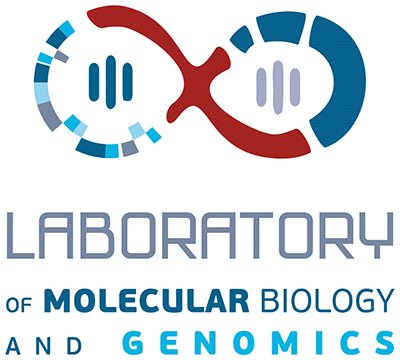
Laboratory of Molecular Biology & Genomics
Τμήμα Βιοχημείας και Βιοτεχνολογίας (1st Floor)
University of Thessaly
Viopolis, 41500 – Larissa
Contact
olflylab-at-gmail.com
kmathiop-at-bio.uth.gr
agiakountis-at-uth.gr
anspana-at-gmail.com






